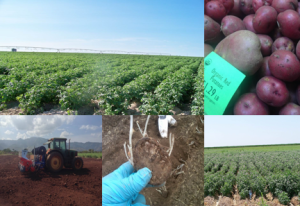 Maintaining soil and plant health through crop rotations is critical to the profitability of the leases in DNR’s land base over both the short and long term. Because DNR-managed acreage is for perpetual use to benefit the Common School Trust, rotations and diversity are necessary to safeguard the quality of the land base. Diversity of rotation affects all parties: from the lessees to the school districts that receive construction funds from DNR’s leases.
Maintaining soil and plant health through crop rotations is critical to the profitability of the leases in DNR’s land base over both the short and long term. Because DNR-managed acreage is for perpetual use to benefit the Common School Trust, rotations and diversity are necessary to safeguard the quality of the land base. Diversity of rotation affects all parties: from the lessees to the school districts that receive construction funds from DNR’s leases.
Crop rotation can be defined as any cropping structure that creates biodiversity, prevents resistance of disease to inputs used by the lessees, and provides the basis to increase or at least maintain soil organic matter and flora. Simply put, monoculture of rotational crops provides breeding grounds for loss of income due to soil disease from pests such as nematodes, insects, weeds, plant parasitic fungi and bacteria, that flourish on lands where crops are in short rotation.
An example of how the lack of diversity and short rotations impact the natural environment is on the island of Oahu. Lands used for decades to grow pineapple are being returned to native Hawaiians are found to be infested with nematode, invasive weed species, resistant fungi and other parasitic pests — all the result of past agricultural practices. At first the land was fertile from the biodiversity of the native vegetation. Then a monoculture with one primary crop began. Machinery brought in weeds and other plant pests into areas that were once free of disease. Because of competition to grow crops ever cheaper and improve yield, fumigants were used extensively and programmed into the growing of the pineapple. Native Hawaiians now must deal with the disarray, clean it up and reintroduce crop biodiversity to eliminate resistant pests.
The situation in Hawaii is not unlike that of the potato industry. Washington state leads the world in potato yield per acre but the crop brings in adhering soil from the seed source that may contain fungi or nematodes that, for example, may negatively affect the skin finish of the potato. At first, fumigation was used to rid the soil of the pests and weeds. Shortening up the rotations from a one potato crop in (5) years to a one potato crop in (3) years increased revenue for the trust but it also began the process where rotation becomes key again.
The soil on many of the lands in Washington state with which DNR is entrusted is the best in the world; it is very similar to Hawaii’s virgin pineapple growing areas. At first the soils here produced huge yields without fumigation and Washington state became a major factor in global potato production. Now the honeymoon is over. Fumigation, combined with fertilizer additions, helped maintain yields for a while but now disease agents are becoming resistant to fumigation agents. Some of the weed population is also now resistant to herbicides. Fungi such as silver scurf and blackdot are becoming more prevalent in fresh pack situations.
Fumigation is almost a programmed event: eventually, diseases like pink rot will impact the processing crop of russet varieties. The way out of this downward spiral is to maintain rotations where disease resistance is broken, and annual fumigation is not necessary. Think about it another way: McDonald’s recently announced that it will not buy chicken from companies that use antibiotics in their feed rations. The company took this step because humans use the same antibiotics and the increased prevalence of antibiotic use in the general population has led new strains of bacteria that are resistant to antibiotics.
Our food system needs rich diversity and DNR-managed trust lands need this rich diversity of rotational crops to support public school construction for Washington state’s children into perpetuity.
By Jeff Bragg, DNR Agriculture Manager, Southeast Region, jeff.bragg@dnr.wa.gov
